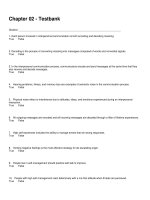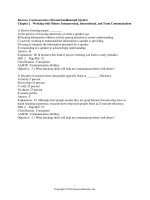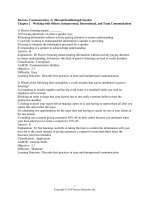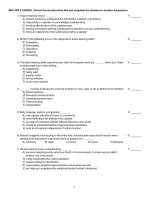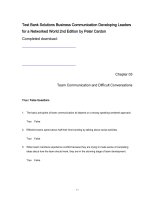business communication developing leaders networked world 3rd edition cardon solutions manual
Bạn đang xem bản rút gọn của tài liệu. Xem và tải ngay bản đầy đủ của tài liệu tại đây (3.22 MB, 126 trang )
Instructor’s Manual to Accompany
BUSINESS COMMUNICATION
Developing Leaders for a Networked World (3e)
By Peter W. Cardon
Chapter 2:
Interpersonal Communication and Emotional
Intelligence
IM 2-1
Copyright © 2018 McGraw-Hill Education. All rights reserved. No reproduction or distribution without the prior written consent of McGrawHill Education.
Teaching Note
Hello Fellow Instructor,
Strong interpersonal skills have always been a key to professional success. However, in the past five
years, I’ve noticed an even increased demand among employers for interpersonal skills.
A lot of factors in the contemporary workplace can hinder effective interpersonal communication,
including various communication technologies, the fast pace of business, and other pressures and
disruptions in the workplace.
This chapter is an opportunity to start a conversation about building deep, collaborative relationships in
the workplace. Furthermore, it provides the language to talk about business relationships in every
remaining chapter.
Please contact me anytime—to share your experiences, your ideas, and your requests.
Best of wishes,
Peter W. Cardon, MBA, Ph.D.
Professor, Department of Business Communication
Academic Director, MBA for Professionals and Managers
University of Southern California
Email:
Twitter: @petercardon
Pinterest: pinterest.com/cardonbcom
IM 2-2
Copyright © 2018 McGraw-Hill Education. All rights reserved. No reproduction or distribution without the prior written consent of McGrawHill Education.
Learning Objectives
Learning Objective: 02-01 Describe the interpersonal communication process and barriers to effective
communication.
Learning Objective: 02-02 Explain how emotional hijacking can hinder effective interpersonal
communication.
Learning Objective: 02-03 Explain how self-awareness impacts the communication process.
Learning Objective: 02-04 Describe how self-management impacts the communication process.
Learning Objective: 02-05 Explain and evaluate the process of active listening.
Learning Objective: 02-06 Describe and demonstrate effective questions for enhancing listening and
learning.
Learning Objective: 02-07 Explain strategies to sight-read the nonverbal communication of others.
Learning Objective: 02-08 Identify common communication preferences based on motivational values.
Learning Objective: 02-09 Explain how extroversion-introversion impacts interpersonal communication.
Learning Objective: 02-10 Explain the role of civility in effective interpersonal communication and the
common types of incivility in the workplace.
Connect Application Exercises
Behaviors Associated with Emotional Intelligence
The Interpersonal Communication Process in a Charged Negotiation
Steps in Active Listening
Evaluating SDI Communication Styles
Identifying SDI Communication Styles
SA 2.1: Listening Self-Assessment
IM 2-3
Copyright © 2018 McGraw-Hill Education. All rights reserved. No reproduction or distribution without the prior written consent of McGrawHill Education.
Chapter 2 Summary and PowerPoint Notes
SLIDE 2-1
SLIDE 2-2
LO2.1 Describe the interpersonal
communication process and barriers to effective
communication.
LO2.2 Explain how emotional hijacking can
hinder effective interpersonal communication.
LO2.3 Explain how self-awareness impacts the
communication process.
LO2.4 Describe how self-management impacts
the communication process.
LO2.5 Explain and evaluate the process of active
listening.
IM 2-4
Copyright © 2018 McGraw-Hill Education. All rights reserved. No reproduction or distribution without the prior written consent of McGrawHill Education.
SLIDE 2-3
LO2.6 Describe and demonstrate effective
questions for enhancing listening and learning.
LO2.7 Explain strategies to sight-read the
nonverbal communication of others.
LO2.8 Identify common communication
preferences based on motivational values.
LO2.9 Explain how extroversion-introversion
impacts interpersonal communication.
LO2.10 Explain the role of civility in effective
interpersonal communication and the common
types of incivility in the workplace.
SLIDE 2-4
This chapter covers the following topics:
communication process and barriers to
communication; emotional hijacking and selfawareness; impacts of self-management;
empathy, including active listening, barriers to
listening, asking questions, avoiding the traps of
empathy, and sight-reading nonverbal
communication; relationship management,
including communication preferences and the
impact of introversion-extroversion; and
maintaining civil communication.
SLIDE 2-5
In nearly any poll of skills needed for career
success, employees identify interpersonal skills
as the most important. For example, consider
the results of a recent Gallup poll of working
adults, depicted in Table 2.1. More than any
other item in the survey, respondents
recognized “skill in dealing with people” as the
most critical.
IM 2-5
Copyright © 2018 McGraw-Hill Education. All rights reserved. No reproduction or distribution without the prior written consent of McGrawHill Education.
SLIDE 2-6
To engage in effective interpersonal
communication, focus on the following two
tasks:
Task 1 Overcome barriers to communication.
Task 2 Manage emotions to engage in
constructive communication.
SLIDE 2-7
We often take the interpersonal communication
process for granted, rarely thinking about its
building blocks and how they influence the
quality of our communications. However,
consciously becoming aware of these basic
elements can help you improve your
interpersonal communications skills and work
more effectively with others. The interpersonal
communication process is the process of
sending and receiving verbal and nonverbal
messages between two or more people. It
involves the exchange of simultaneous and
mutual messages to share and negotiate
meaning between those involved.
See Connect Application Exercise: The
Interpersonal Communication Process in a
Charged Negotiation
IM 2-6
Copyright © 2018 McGraw-Hill Education. All rights reserved. No reproduction or distribution without the prior written consent of McGrawHill Education.
SLIDE 2-8
The interpersonal communication process,
depicted in Figure 2.1, is the process of sending
and receiving verbal and nonverbal messages
between two or more people.
SLIDE 2-9
Each person involved in interpersonal
communication is both encoding and decoding
meaning. Meaning refers to the thoughts and
feelings that people intend to communicate to
one another.
SLIDE 2-10
Encoding is the process of converting meaning
into messages composed of words and
nonverbal signals. Decoding is the process of
interpreting messages from others into
meaning. In the interpersonal communication
process, communicators encode and send
messages at the same time that they also
receive and decode messages.
IM 2-7
Copyright © 2018 McGraw-Hill Education. All rights reserved. No reproduction or distribution without the prior written consent of McGrawHill Education.
SLIDE 2-11
One goal of interpersonal communication is to
arrive at shared meaning—a situation in which
people involved in interpersonal communication
attain the same understanding about ideas,
thoughts, and feelings.
SLIDE 2-12
In practice, many barriers interfere with
achieving shared meaning, including external
noise, internal noise, and lifetime experiences.
Noise causes distortion to or interruption of
messages. Four types of noise affect the quality
of message delivery: physical noise,
physiological noise, semantic noise, and
psychological noise. Physical noise is external
noise. The other three types of noise are
distortions or interruptions of messages that are
caused by internal characteristics of
communicators.
See Connect Application Exercise: The
Interpersonal Communication Process in a
Charged Negotiation
IM 2-8
Copyright © 2018 McGraw-Hill Education. All rights reserved. No reproduction or distribution without the prior written consent of McGrawHill Education.
SLIDE 2-13
Physical noise is external noise that makes a
message difficult to hear or otherwise receive.
Examples include loud sounds nearby that
interrupt verbal signals or physical barriers that
prevent communicators from observing
nonverbal signals. Physical noise can also be a
function of the medium used. A poor signal for a
phone conversation and blurry video feed for a
teleconference are examples of physical noise.
Physiological noise refers to disruption due to
physiological factors. Examples include hearing
problems, illness, memory loss, and so on.
Conversely, a communicator may have a
difficult time sending a message due to
physiological constraints such as stuttering,
sickness, or other temporary or permanent
impairments.
SLIDE 2-14
Semantic noise occurs when communicators
apply different meanings to the same words or
phrases. For example, two people may have
different ideas about what an acceptable profit
margin means. One manager may have a figure
in mind, such as 10 percent. Another may think
of a range between 20 and 30 percent.
Semantic noise can be most difficult to
overcome when strong emotions are attached
to words or phrases.
Psychological noise refers to interference due
to attitudes, ideas, and emotions experienced
during an interpersonal interaction. In many
cases, this noise occurs due to the current
conversation—the people involved or the
content. The demanding impacts of day-to-day
business can create psychological noise for
many reasons.
IM 2-9
Copyright © 2018 McGraw-Hill Education. All rights reserved. No reproduction or distribution without the prior written consent of McGrawHill Education.
SLIDE 2-15
All outgoing messages are encoded and all
incoming messages are decoded through a filter
of lifetime experiences. This filter is an
accumulation of knowledge, values,
expectations, and attitudes based on prior
personal experiences. When people have more
shared experiences, communication is easier.
However, people who grew up in different
communities or cultures and at different times,
who have different educational backgrounds,
and who have worked in different industries are
far more likely to filter incoming messages
differently. As a result, they are more likely to
encounter noise and are less equipped to deal
with the noise.
SLIDE 2-16
The ability to manage effective interpersonal
communication depends on emotional
intelligence. Emotional intelligence involves
understanding emotions, managing emotions to
serve goals, empathizing with others, and
effectively handling relationships with others.
Business managers with high emotional
intelligence are more effective at influencing
others, overcoming conflict, showing leadership,
collaborating in teams, and managing change.
Furthermore, research has shown emotional
intelligence leads to better outcomes in
business reasoning and strategic thinking. You
may see emotional intelligence referred to as
EQ, which stands for emotional quotient, a play
on the term IQ, intelligence quotient.
See Connect Application Exercise: Behaviors
Associated with Emotional Intelligence
See Connect Application Exercise: The
Interpersonal Communication Process in a
Charged Negotiation
IM 2-10
Copyright © 2018 McGraw-Hill Education. All rights reserved. No reproduction or distribution without the prior written consent of McGrawHill Education.
SLIDE 2-17
The primary reason that emotional intelligence
is so critical is physiological: People are
hardwired to experience emotions before
reason. All signals to the brain first go through
the limbic system, where emotions are
produced, before going to the rational area of
the brain (see Figure 2.3).
People may experience emotional hijacking, a
situation in which emotions control our
behavior causing us to react without thinking.
The impacts of emotions last long after they’ve
subsided. Emotional hijacking prevents you
from engaging in effective interpersonal
communication. It can lead to unwanted
behaviors.
SLIDE 2-18
The most-used EQ test for business
professionals shows that emotional intelligence
can be divided into four domains: selfawareness, self-management, empathy, and
relationship management. Strategies exist for
improving your emotional intelligence in each of
these domains to achieve more effective
interpersonal communication in the workplace.
IM 2-11
Copyright © 2018 McGraw-Hill Education. All rights reserved. No reproduction or distribution without the prior written consent of McGrawHill Education.
SLIDE 2-19
Self-awareness is the foundation for emotional
intelligence. It involves accurately
understanding your emotions as they occur and
how they affect you. One prominent researcher
defines self-awareness as “ongoing attention to
one’s internal states.” People high in selfawareness understand their emotions well,
what satisfies them, and what irritates them.
Understanding your emotions as they occur is
not always easy. In fact, research indicates that
just 36 percent of people can accurately identify
their emotions as they occur.
SLIDE 2-20
Table 2.2 shows differences in low versus high
self-awareness in the encounter between Jeff
and Latisha.
SLIDE 2-21
Table 2.2 shows differences in low versus high
self-awareness in the encounter between Jeff
and Latisha.
IM 2-12
Copyright © 2018 McGraw-Hill Education. All rights reserved. No reproduction or distribution without the prior written consent of McGrawHill Education.
SLIDE 2-22
Self-management is the “ability to use
awareness of your emotions to stay flexible and
to direct your behavior positively.” It involves
the discipline to hold off on current urges to
meet long-term intentions. Excellent selfmanagers know how to use both positive and
negative emotions to meet personal and
business goals. Self-management involves far
more than corralling anger. It involves
responding productively and creatively to
feelings of self-doubt, worry, frustration,
disappointment, and nervousness. It also
includes tempering oneself when experiencing
excitement and elation.
SLIDE 2-23
People can quickly control moderate negative
emotions. For example, an individual who tries
to understand mitigating information can
short-circuit moderate anger almost
immediately. Mitigating information involves
favorable explanations for why others have
behaved in a certain way. See Table 2.4 for
examples of low versus high self-management
and the use of mitigating information.
IM 2-13
Copyright © 2018 McGraw-Hill Education. All rights reserved. No reproduction or distribution without the prior written consent of McGrawHill Education.
SLIDE 2-24
People can quickly control moderate negative
emotions. For example, an individual who tries
to understand mitigating information can
short-circuit moderate anger almost
immediately. Mitigating information involves
favorable explanations for why others have
behaved in a certain way. See Table 2.4 for
examples of low versus high self-management
and the use of mitigating information.
SLIDE 2-25
Empathy is the “ability to accurately pick up on
emotions in other people and understand what
is really going on with them.” Empathy also
includes the desire to help others develop in
their work responsibilities and career objectives.
SLIDE 2-26
Michael Hoppe of the Center for Creative
Leadership has defined active listening as “a
person’s willingness and ability to hear and
understand. At its core, active listening is a state
of mind.… It involves bringing about and finding
common ground, connecting to each other, and
opening up new possibilities.” Hoppe breaks
down active listening into six skills: (1) paying
attention, (2) holding judgment, (3) reflecting,
(4) clarifying, (5) summarizing, and (6) sharing.
See Connect Application Exercise: Steps in
Active Listening
IM 2-14
Copyright © 2018 McGraw-Hill Education. All rights reserved. No reproduction or distribution without the prior written consent of McGrawHill Education.
SLIDE 2-27
This first step involves devoting your whole
attention to others and allowing them enough
comfort and time to express themselves
completely. As others speak to you, try to
understand everything they say from their
perspective. Paying attention requires active
nonverbal communication. Your body language,
including appropriate eye contact, should show
you are eager to understand the other person.
Lean forward. Keep an open body position. Sit
up straight. Nod to show you are listening. Smile
as appropriate. Pay attention to the speaker’s
nonverbal behaviors. Avoid any distractions.
Become comfortable with silence.
SLIDE 2-28
People will share their ideas and feelings with
you only if they feel safe. Holding judgment is
particularly important in tense and emotionally
charged situations. One of the best ways to
make others feel comfortable expressing
themselves fully is to demonstrate a learner
mind-set rather than a judger mind-set. Holding
judgment does not mean that you agree with
everything you hear. It also does not mean you
avoid critiquing the ideas of others. Rather, it’s
a commitment to hearing the entire version of
others’ ideas and experiences. It’s a
commitment to listen fully before reacting. And,
it’s a mind-set of rewarding others for opening
up, especially when you disagree with them.
IM 2-15
Copyright © 2018 McGraw-Hill Education. All rights reserved. No reproduction or distribution without the prior written consent of McGrawHill Education.
SLIDE 2-29
In a learner mind-set, you show eagerness to
hear others’ ideas and perspectives and listen
with an open mind. You do not have your mind
made up before listening fully. When you
disagree, you stay open to the possibility of
finding common ground and mutually beneficial
solutions. Under the learner mind-set,
difference of opinion is considered normal, even
healthy, and potentially solution producing.
SLIDE 2-30
In a judger mind-set, people have their minds
made up before listening carefully to others’
ideas, perspective, and experiences. Judgers
view disagreement rigidly, with little possibility
of finding common ground unless the other
person changes his or her views. Judging often
involves punishing others for disagreement. At
its extreme, the judger mind-set involves
ascribing negative traits to others and labeling
them in undesirable terms.
SLIDE 2-31
You can create an environment in which others
open up and you can listen more effectively
with learner statements, which show your
commitment to hearing people out. In effective
learner statements, you explicitly state your
desire to hear differing opinions with
statements such as “I have a different
perspective, so I want to understand how you
see this.” By contrast, people who make judger
statements, which show they are closed off to
hearing people out, shut down honest
conversations.
IM 2-16
Copyright © 2018 McGraw-Hill Education. All rights reserved. No reproduction or distribution without the prior written consent of McGrawHill Education.
SLIDE 2-32
Notice the distinctions between judger
statements and learner statements in this
conversation in Table 2.6.
SLIDE 2-33
Notice the distinctions between judger
statements and learner statements in this
conversation in Table 2.6.
SLIDE 2-34
Active listening requires that you reflect on the
ideas and emotions of others. To make sure you
really understand others, you should frequently
paraphrase what you’re hearing.
IM 2-17
Copyright © 2018 McGraw-Hill Education. All rights reserved. No reproduction or distribution without the prior written consent of McGrawHill Education.
SLIDE 2-35
As Table 2.7 shows, good reflecting statements
begin with phrases such as, “It sounds to me
like…”; “So, you’re not happy with…”; or “Let
me make sure I understand.…”
SLIDE 2-36
Clarifying involves making sure you have a clear
understanding of what others mean. It includes
double-checking that you understand the
perspectives of others and asking them to
elaborate and qualify their thoughts. It is more
than simply paraphrasing. It involves trying to
connect the thoughts of others so you can
better understand how they are making
conclusions.
SLIDE 2-37
As Table 2.8 shows, good clarifying questions
are open-ended and start with learner-oriented
phrases such as, “What are your thoughts
on…?” or “Could you explain how…?”
IM 2-18
Copyright © 2018 McGraw-Hill Education. All rights reserved. No reproduction or distribution without the prior written consent of McGrawHill Education.
SLIDE 2-38
The goal of summarizing is to restate major
themes so that you can make sense of the big
issues from the perspective of the other person.
Ideally, you can show that you understand the
major direction of the conversation.
Active listening also involves expressing your
own perspectives and feelings. If you do not
share your own ideas completely, your
colleagues do not know what you really think.
This is not fair to them or to you. It is even
arguably dishonest.
SLIDE 2-39
You can summarize with statements that begin
with phrases such as “So, your main concern
is…” or “It sounds as though your key points
are…,” as shown in Table 2.9.
SLIDE 2-40
Active listening is not easy, especially in certain
corporate cultures and in the face of time
constraints. Some barriers to listening are lack
of time, lack of patience and attention span,
image of leadership, communication
technology, fear of bad news or uncomfortable
information, defending, “me too” statements,
giving advice, and judging. Consider which
barriers to listening are most challenging to you.
IM 2-19
Copyright © 2018 McGraw-Hill Education. All rights reserved. No reproduction or distribution without the prior written consent of McGrawHill Education.
SLIDE 2-41
Figure 2.4 displays defensive and non-defensive
replies to a potentially upsetting comment.
Avoiding defensiveness requires a high level of
self-awareness and self-management. It
requires understanding the triggers that make
you feel threatened in a professional
environment. It also requires understanding
how to manage these emotions so that you can
maintain your roles as an active listener and a
problem solver.
SLIDE 2-42
Listening involves a cluster of communication
skills. A crucial one is the ability to ask the right
questions. On the most fundamental level, good
questions reflect the learner mind-set, and poor
questions reflect a judger mind-set. The ability
to ask good questions creates a culture of
learning. Good questions are not good in and of
themselves, however. Unless you truly listen to
the answers and even encourage other
perspectives and dissent, you may not achieve
learning.
SLIDE 2-43
Listening involves a cluster of communication
skills. A crucial one is the ability to ask the right
questions. On the most fundamental level, good
questions reflect the learner mind-set, and poor
questions reflect a judger mind-set. The ability
to ask good questions creates a culture of
learning. Good questions are not good in and of
themselves, however. Unless you truly listen to
the answers and even encourage other
perspectives and dissent, you may not achieve
learning. Notice examples of questions in Table
2.10 that reflect judger mind-sets and learner
mind-sets.
IM 2-20
Copyright © 2018 McGraw-Hill Education. All rights reserved. No reproduction or distribution without the prior written consent of McGrawHill Education.
SLIDE 2-44
Generally speaking, most good questions are
open-ended. In contrast, closed questions
require simple responses such as yes or no.
Some basic types of learning-centered questions
include rapport-building questions, funnel
questions, probing questions, and solutionoriented questions. See Table 2.11 for examples
of each type of question.
SLIDE 2-45
Generally speaking, most good questions are
open-ended. In contrast, closed questions
require simple responses such as yes or no.
Some basic types of learning-centered questions
include rapport-building questions, funnel
questions, probing questions, and solutionoriented questions. See Table 2.11 for examples
of each type of question.
SLIDE 2-46
Generally speaking, most good questions are
open-ended. In contrast, closed questions
require simple responses such as yes or no.
Some basic types of learning-centered questions
include rapport-building questions, funnel
questions, probing questions, and solutionoriented questions. See Table 2.11 for examples
of each type of question.
IM 2-21
Copyright © 2018 McGraw-Hill Education. All rights reserved. No reproduction or distribution without the prior written consent of McGrawHill Education.
SLIDE 2-47
Generally speaking, most good questions are
open-ended. In contrast, closed questions
require simple responses such as yes or no.
Some basic types of learning-centered questions
include rapport-building questions, funnel
questions, probing questions, and solutionoriented questions. See Table 2.11 for examples
of each type of question.
SLIDE 2-48
Most poor questions fall into the category of
the judger mind-set and can actually lead to less
listening. Poor questions include leading
questions, disguised statements, and crossexamination questions. Table 2.12 provides
examples.
SLIDE 2-49
Most poor questions fall into the category of
the judger mind-set and can actually lead to less
listening. Poor questions include leading
questions, disguised statements, and crossexamination questions. Table 2.12 provides
examples.
IM 2-22
Copyright © 2018 McGraw-Hill Education. All rights reserved. No reproduction or distribution without the prior written consent of McGrawHill Education.
SLIDE 2-50
Most poor questions fall into the category of
the judger mind-set and can actually lead to less
listening. Poor questions include leading
questions, disguised statements, and crossexamination questions. Table 2.12 provides
examples.
SLIDE 2-51
Givers frequently help others out in the
workplace, whereas takers often accept help
but infrequently reciprocate. The highest
performers are most often givers. Yet, the
weakest performers are also most often givers.
In other words, some givers manage their
generosity in a way that improves their own
performance and those around them while
other givers help others at the expense of their
individual performance.
Givers are generally motivated by empathy.
They perform best when they address three
potential barriers to performance associated
with empathy: timidity, availability, and
emotional concern for others.
IM 2-23
Copyright © 2018 McGraw-Hill Education. All rights reserved. No reproduction or distribution without the prior written consent of McGrawHill Education.
SLIDE 2-52
People can learn sight-reading, which David
Givens of the Center for Nonverbal Studies
defines as “intelligent observation [of nonverbal
communications]… it is the act of anticipating
intentions and moods through the perceptive
examination of nonverbal cues.” Generally, you
should pay close attention to nonverbal signals
and attempt to decode their meanings. Yet, you
should always make sure to suspend a certain
level of judgment and avoid rigid conclusions.
Consider the following guidelines as you
develop your sight-reading:
• Consciously practice each day.
• Pay attention to congruence.
• Sight-read in clusters, not in isolation.
• Sight-read in context.
See Connect Application Exercise: SA 2.1:
Listening Self-Assessment
SLIDE 2-53
Relationship management is the “ability to use
your awareness of emotions and those of others
to manage interactions successfully.” In this
chapter we introduce the following principles
for managing relationships effectively: adapting
communication to the preferred styles of others
and ensuring civility in the workplace.
IM 2-24
Copyright © 2018 McGraw-Hill Education. All rights reserved. No reproduction or distribution without the prior written consent of McGrawHill Education.
SLIDE 2-54
Many communication styles can be traced to
motives and values. Relationship Awareness
Theory explains how professionals often act and
communicate differently from one another
based on a fairly constant set of motives and
values. People have a blend of three primary
motives: nurturing (identified as blue in this
model), directing (identified as red), and
autonomizing (identified as green). A person’s
motivational value system (MVS) is a blend of
these primary motives and refers to the
frequency with which these values guide their
actions.
See Connect Application Exercise: Evaluating SDI
Communication Styles
See Connect Application Exercise: Identifying
SDI Communication Styles
SLIDE 2-55
Professionals with a blue MVS are most often
guided by motives to protect others, help others
grow, and act in the best interests of others.
About 30 percent of business managers are
strongly aligned with blue motivations.
Professionals with a red MVS are most often
guided by concerns about organizing people,
time, money, and other resources to accomplish
results. About 46 percent of business managers
are strongly aligned with red motivations.
IM 2-25
Copyright © 2018 McGraw-Hill Education. All rights reserved. No reproduction or distribution without the prior written consent of McGrawHill Education.




